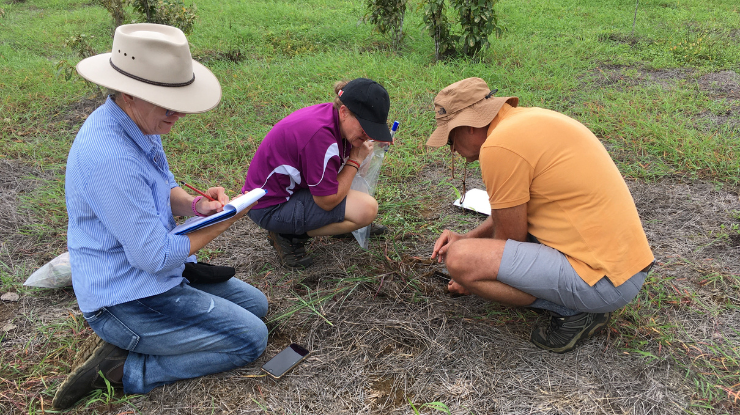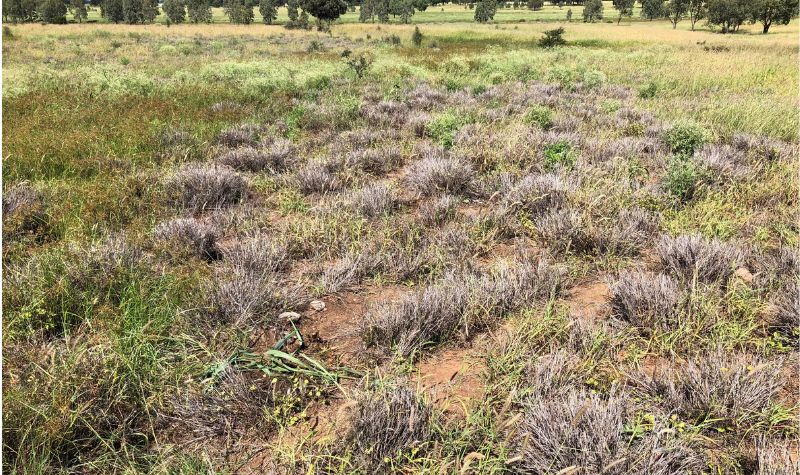
Two MLA-co-funded projects run by Queensland’s Department of Agriculture and Fisheries (DAF) have unearthed new findings about the causes of pasture dieback, and how best to manage it.
Stuart Buck, DAF Principal Pastures Agronomist, and his team collected thousands of samples from across Queensland to better understand the causes.
They set up six on-farm trial sites to determine how best to manage pastures affected by dieback.
The team examined the role of mealybugs, which are known to cause classic dieback symptoms, but also looked at other insects, as well as bacteria, fungi and viruses, undertaking a range of diagnostic tests and analysis, including on-farm trials.
“Our on-farm trials demonstrate mealybugs can cause pasture dieback,” Stuart said.
“However, microbiome diagnostic testing indicates they may be working in combination with a virus or something else to cause the full suite of dieback symptoms, including the final ashy grey appearance of affected pasture.”
Digging into the variables
While mealybugs cause dieback, there may be other causes of dieback-like symptoms. For example, at DAF’s Boonah trial site, the paddock grew Rhodes grass for around 10 years before succumbing to dieback in 2019 with mealybugs present in the pasture.
When the grass species trial was planted in February 2020, patches of dieback again occurred in some Rhodes grass plots. However, no mealybugs were detected despite multiple inspections by trained scientists over a 12-month period.
The team brought mealybugs into the trial at the end of 2020 to assess their impact on the 30 grass species planted.
“We have seen that some grass species can coexist with mealybugs quite happily, whereas others are very susceptible and can die out,” Stuart said.
When the DAF team assessed hundreds of paddocks with dieback across southern, central and north Queensland, their findings demonstrated that numerous variables determined whether dieback took hold.
“We sampled a massive geographical area, taking thousands of samples to find out why variability in dieback severity occurs,” Stuart said.
“Some producers believe dieback is more prevalent on the cracking clay soils, as opposed to the non-cracking soils, but our objective surveying process and field sampling didn’t pick up any differences in soil type.”
Three contributing factors
The researchers believe three broad factors need to come together for dieback to occur:
- the presence of pathogenic organisms
- environmental stressors
- specific pasture management practices.
“One necessary element is the presence of pathogenic organisms,” Stuart said.
“Multiple pathogenic organisms are usually present in pastures with dieback, including mealybugs.
“We also see many fungal pathogens including one called buffel grass blight, which is commonly associated with dieback in buffel grass pastures.
“Environmental stress such as heat and/or moisture stress is also needed for dieback to affect large patches or whole paddocks.
“The third aspect that’s needed is the right species of grasses managed in a certain way; what I classify as pasture management.”
Susceptible grasses
The team had already noted that some grasses—such as Gayndah and American buffel grass, Bisset bluegrass, Nixon sabi grass and pangola—were highly susceptible, whereas others—such as Biloela buffel grass and Mekong Brizantha—were more tolerant.
If a producer’s dominant pasture species is susceptible, and if it’s managed well from a land condition point of view with high biomass, those pastures are more commonly affected by dieback than shorter pastures that have been more heavily grazed.
“These three things need to happen together, and I suspect this is why we see such variation across landscapes or properties,” Stuart said.
“In some cases, only one or two factors are present so dieback might not occur, whereas if all three occur together, dieback usually happens.”
Monitor regularly
Stuart said producers should regularly monitor their paddocks and be on the lookout for dieback, however, the identification process can be difficult. This is because other pasture conditions, such as nutrient or water stress, can generate similar symptoms, especially initially.
DAF has produced fact sheets to upskill producers on dieback identification, and an identification guide is also available.
Once dieback is detected, it’s important to determine what level of impact it’s having, because although it starts in very small patches, it can spread quickly.
“If there are only small patches here and there, we found the best thing to do is just watch it and graze the remaining feed in the paddock,” Stuart said. “But if it’s quickly spreading and affecting tens or hundreds of hectares, other options come into play.”

Pasture dieback visible in a buffel grass pasture in Central Queensland.
Pasture management
Perennial pastures have an excellent capacity to regenerate from the seedbank, but it is here that pasture management plays an important role.
Stuart said when producers actively manage the grazing pressure on pasture that’s trying to recover, by spelling the paddock once the pasture’s coming back by taking the cattle off, then the pasture regenerates much quicker.
Where possible, spraying broadleaf weeds also speeds up the pasture recovery process.
Producers can also reseed to actively change the species composition in that paddock, especially with legumes and tolerant grasses.
“It’s challenging to resow if you don’t have the right gear, but our field trials are showing it is a successful way to overcome production loss from dieback,” Stuart said.
“However, in some instances the resown grass has been affected by pasture dieback. Therefore it is important to sow more tolerant grass varieties.”
If reseeding, it’s also important to include a perennial legume in the mix (ensure adequate soil nutrients including phosphorous to aid establishment) because legumes are resistant to dieback. Growing a forage such as sorghum, lab lab or oats for a year or two before replanting with perennial pastures has also proven very successful, and the following pastures have performed very well too.
Stuart said good pasture management must be the cornerstone of the beef production system going forward.
“We know enough now to provide useful solutions to reduce the impact of pasture dieback and restore productivity—and in many cases make the pasture better than it was before.
“There are challenges identifying highly tolerant grasses however, there are grasses that are more tolerant than Gayndah buffel or Bisset bluegrass, which have been the main varieties used over large areas of Queensland.
We’re using our existing knowledge to improve our pastures—that is, put legumes in, make sure there is adequate soil fertility and graze them the right way—and are continuing research and development to identify better grass varieties options.
“It’s about monitoring pastures, accurately diagnosing what is happening then getting the right advice to implement the most suitable practices for the situation.”
Meet producer Warren Luhrs from Moura who took part in a Queensland’s Department of Agriculture and Fisheries (DAF) trial on pasture dieback
Seasonal action plan
- Regularly monitor pastures, starting in spring through to autumn, to diagnose whether dieback is present, and the area impacted.
- If dieback is present, obtain advice about the best management strategy for the situation: manage for recovery, improve the pasture, sow a break crop or control the pathogen.
- Implement the appropriate management strategy and monitor the pasture for recovery.
Learn more







